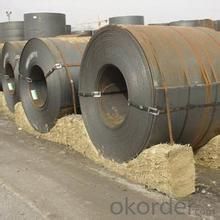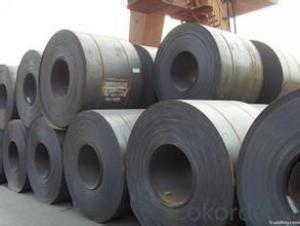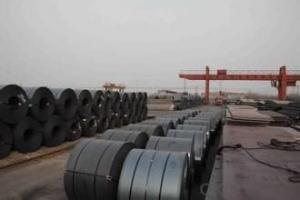Hot Rolled Steel plate Sheet - SAE 1006/1008
- Loading Port:
- Tianjin
- Payment Terms:
- TT OR LC
- Min Order Qty:
- 20 m.t.
- Supply Capability:
- 500000 m.t./month
OKorder Service Pledge
OKorder Financial Service
You Might Also Like
Description of hold rolled steel coil:
Rolled to its final dimensions while it’s hot enough to scale, our hot-rolled steel is an amalgamation of the various qualities of steel. It can be in the form of plates, sheets and coils.
Specifications of hold rolled steel coil:
Product: | Hot Rolled Steel Coils/Sheets |
Material: | Q195,Q235,A36,SS400,S235JR,Q345,ST37-2, CCSB etc |
Standard : | JIS G3002 GB/T251B |
Technique: | hot rolled |
Thickness | 1.2mm to 200mm |
Tolerance of thickness: | :+/-0.03mm |
Width: | 750mm-2000mm |
Tolerance of width: | :+/-5.00mm (aiming to +/-2.00mm) |
Normal width: | 914mm, 1000mm, 1200mm, 1219mm, 1250mm,1500mm |
Length: | According to requirement |
Coil ID: | 508mm-610mm |
Coil Weight: | 10-25 Metric Tons |
Surface: | Black, Chromate, fingerprint resistant treatment, slight oiled or non-oiled, dry |
Port of Loading: | Tianjin/Shanghai port |
Packaging Details: | Standard export packing or according to the clients required |
Delivery Time | Within 30 days after received 30% deposit or workable L/C |
Payment Terms: | L/C,T/T |
Images of hold rolled steel coil:


Our Hot-Rolled Steel Sheets and Coils are applied to a wide range of uses such as automobile, electrical appliance, machinery manufacturing, container manufacturing, shipbuilding, bridge, pipeline, and receive high acclaim from our customers for its excellent quality.
- Q:like building steel beams. i'm pretty sure with a sawzall.
- I am going to take a slightly different approach. Once the structural steel is manufactured and then brought to the fabricator, not much heat is applied to the steel. It is normally punched, sheared or whatever buy the use of a lot of heat on it is normally not allowed due to the change in the properties of the steel. Once in the field to be erected, the cutting or welding on it are held to absolute minimums and most of the time not allowed at all.
- Q:How are steel coils used in the manufacturing of agricultural irrigation systems?
- Steel coils are used in the manufacturing of agricultural irrigation systems as they are shaped and formed into various components such as pipes, tubes, and fittings. These coils provide strength, durability, and corrosion resistance, ensuring the longevity and reliability of the irrigation system.
- Q:How do steel coils contribute to the aerospace industry?
- The aerospace industry benefits greatly from the utilization of steel coils. They serve multiple purposes in this field. Firstly, they are instrumental in the production of aircraft structures and components. Steel coils can be transformed into various forms, such as sheets or plates, which can then be shaped and welded to create essential parts of an aircraft, including wings, fuselage, and landing gear. The exceptional strength and durability of steel make it an optimal material for such critical components, guaranteeing the safety and dependability of the aircraft. Secondly, steel coils play a pivotal role in the manufacturing of jet engines. The extreme conditions and high temperatures that engines endure necessitate materials with outstanding heat resistance and mechanical properties. Steel coils, especially those made from alloys like stainless steel or nickel-based alloys, possess the requisite attributes to withstand the demanding environment within a jet engine. These coils can be processed into turbine blades, exhaust system components, and other engine parts, thereby enhancing the overall performance and efficiency of the aircraft. Furthermore, steel coils find utility in the construction of aerospace infrastructure and ground support equipment. Strong and durable materials are essential for ensuring the stability and longevity of structures like hangars, maintenance facilities, and launch pads. Steel coils are frequently fabricated into beams, columns, and other structural elements that form the foundation of these facilities, providing the necessary strength to withstand the various loads and vibrations associated with aerospace operations. In conclusion, the aerospace industry heavily relies on steel coils due to their indispensable qualities of strength, durability, and heat resistance. These coils contribute significantly to the manufacturing of aircraft structures, engine components, and aerospace infrastructure, thereby guaranteeing the safety, performance, and reliability of aircraft. This, in turn, facilitates the advancement of aviation technology and enables the exploration of new frontiers in aerospace.
- Q:How are steel coils used in the production of aerospace parts?
- Steel coils are used in the production of aerospace parts as they provide a reliable and durable material for manufacturing various components such as engine parts, structural beams, and landing gear. The coils are first processed and shaped into specific forms and sizes, then undergo further fabrication processes like cutting, welding, and machining to create the desired aerospace parts. The high strength and corrosion resistance of steel make it an ideal choice for ensuring the safety and performance of aerospace components.
- Q:420 440 1045 or 1065 ive bought knifes with these steel grades and i want to know which one is better.
- SAE 440 is the best. Classified as high grade cutlery steel. There are various grades of 440: A, B, C, and F. 440 A is the most stain resistant while 440 C has the most carbon and can achieve the highest hardness (Best edge Retention). SAE 440 Chemistry: 16 - 18% Chromium, 0.60 - 1.2% Carbon, 0.75% Molybdenum. SAE 420 is pretty good. Classified as cutlery steel, it is a stain resistant grade but has less chromium and significantly less carbon than SAE 440. SAE 420 Chemistry: 12 - 14% Chromium, 0.15% Carbon (min), 0 Molybdenum Chromium is what makes the steel corrosion resistant. It also adds toughness. Molybdenum adds extra corrosion resistance and adds hardenability. So you can see by chemical components that 440 is highest quality although that also means more cost. 1045 and 1065 are low quality steels and you should probably never use them for a knife. The 1 indicates plain carbon steel with little other alloying elements. The last two digits indicate how much carbon is in the steel. 1045 has 0.45% carbon, mid-range hardenability. 1065 has 0.65% carbon, high hardenability. So if I had to choose I would choose 1065 over 1045 but the difference isn't that noticeable. Everything I said here assumes they have all had the optimum Quench and Temper heat-treatment for their chemistry grade.
- Q:I plan to buy a bushcraft knife ..The blade made up by damascus steel.My question is ,is damascus steel is very strong ?
- Pattern welded /damascus is too expensive to use as an everyday knife, as it can cost more than silver. It's best kept as a collection piece. You'd be stupid to keep it in your pocket or use it everyday. that would be a waste of money. Knives you use everyday might be lost or stolen, or they may get rusted, worn, or dirty..... ruining their value. From that point of view the strength or edge-holding ability means very little. Specifically, the bushcraft knife is pattern welded steel. True damascus or Wootz steel is something you'll only find in museums and private collections. they stopped making it several hundred years ago. Despite what many people have claimed, Wootz damascus was inferior to modern tool steels in every respect. It was a brittle, dirty material. It's legendary status has more to do with myth and storytelling. The reason they stopped making was undoubtaby because more modern methods came along that produced a more consistent product, more quickly and easily. Old technologies tend to be abandoned for good reasons. With pattern welded steel, about a dozen strips of two different grades of steel have been stacked, welded together, the twisted and forged to create interesting patterns. This more of an artistic process and doesn't improve the properties of modern steels. Pattern welded steel is for the most part, inferior to a homogenous blade made of a single grade of steel. First of all, PW is a handmade product which means there will be faults and oxide inclusions incorporated into the steel. The welding process is not perfect. Secondly, in the hardening and tempering process you end up with a compromise between the properties of the two different grades of steel. You end up with a product that is not quite as good as either steel would have been individually. The blade may either be too brittle or too soft.
- Q:How are steel coils coated for corrosion resistance?
- Steel coils are typically coated for corrosion resistance using various methods such as hot-dip galvanizing, electroplating, or applying a protective layer of paint or powder coating.
- Q:What are the common coil grades available for steel coils?
- Steel coils come in different grades, each with its own distinct properties and uses. Some commonly used grades include: 1. HRC (Hot Rolled Coils): These coils are made by heating a steel slab to its recrystallization temperature and rolling it into a coil. HRC coils are known for their excellent weldability and formability, making them suitable for various applications like construction, automotive manufacturing, and general engineering. 2. CRC (Cold Rolled Coils): CRC coils are produced by further processing HRC coils through cold reduction, which involves passing the steel through rollers at room temperature. CRC coils have a superior surface finish and dimensional accuracy, making them ideal for applications that require a smooth and uniform appearance, such as automotive body panels, appliances, and electrical equipment. 3. GI (Galvanized Coils): GI coils are created by coating regular carbon steel coils with a layer of zinc through a hot-dip galvanizing process. This provides excellent corrosion resistance, making GI coils suitable for outdoor applications like roofing, fencing, and structural components. 4. Stainless Steel Coils: Stainless steel coils are made from different grades, with the most common being austenitic (such as 304 and 316) and ferritic (such as 430). Stainless steel coils offer excellent corrosion resistance, high temperature resistance, and aesthetic appeal, making them widely used in industries like food processing, chemical processing, and architecture. 5. EG (Electro-galvanized Coils): EG coils are similar to GI coils, but the zinc coating is applied using an electrolytic process instead of hot-dipping. EG coils have a thinner and smoother zinc layer, making them suitable for applications that require a brighter and more aesthetic appearance, such as automotive parts, appliances, and decorative items. These are just a few examples of the coil grades available for steel coils. The choice of the right grade depends on factors like the intended application, required mechanical properties, and desired aesthetics. It is important to seek guidance from steel suppliers or industry experts to determine the most suitable coil grade for a specific application.
- Q:What are the dimensions of steel coils used in automotive accessory manufacturing?
- The dimensions of steel coils used in automotive accessory manufacturing can vary depending on the specific application and requirements. However, typical dimensions for steel coils used in this industry range from 0.3 mm to 4.0 mm in thickness and from 600 mm to 2000 mm in width. The length of the coil can also vary, but it is commonly around 2000 meters.
- Q:What are the challenges in coil blanking?
- In order to achieve efficient and accurate production, coil blanking, a process used to cut flat metal sheets from coiled stock, must tackle several challenges. Some of the key challenges include: 1. Material variations: Coiled stock can have variations in thickness, width, and surface quality, which can impact the cutting process and result in inconsistent blanks. To ensure consistent quality and dimensional accuracy, it is crucial to carefully select and control the material. 2. Coil set and crossbow: Coiled stock often has inherent shape imperfections like coil set (longitudinal curvature) and crossbow (transverse curvature), which can cause alignment issues during cutting. Minimizing these imperfections requires the use of specialized equipment and techniques, such as straighteners and leveling systems. 3. Coil edge condition: The edges of coiled stock can have burrs, waves, or irregularities, which can affect the quality and precision of the cut blanks. Employing proper edge conditioning techniques, like deburring or edge trimming, is necessary to ensure clean and straight edges. 4. Slitting and shearing forces: The forces exerted during coil blanking can induce stresses and strains in the material, potentially leading to deformation or springback. To minimize these effects and maintain dimensional accuracy, careful consideration of slitting and shearing forces, along with proper tooling design and machine settings, is necessary. 5. Scrap and material waste: Coil blanking can generate significant amounts of scrap material, especially during setup and adjustment phases. Managing scrap and reducing material waste is crucial to optimize production efficiency and minimize costs. Efficient nesting algorithms and real-time monitoring systems can help achieve this. 6. Automation and productivity: Due to market demands, coil blanking often requires high-speed and high-volume production. Enhancing productivity can be achieved through the implementation of automation systems, such as robotic material handling and advanced control systems. However, integrating and synchronizing these components with the cutting process requires careful planning and system integration expertise. Overall, addressing these challenges in coil blanking necessitates proper material selection, advanced equipment, specialized techniques, and efficient process control. By overcoming these challenges, manufacturers can achieve consistent quality, dimensional accuracy, and productivity in coil blanking operations.
1. Manufacturer Overview |
|
|---|---|
| Location | |
| Year Established | |
| Annual Output Value | |
| Main Markets | |
| Company Certifications | |
2. Manufacturer Certificates |
|
|---|---|
| a) Certification Name | |
| Range | |
| Reference | |
| Validity Period | |
3. Manufacturer Capability |
|
|---|---|
| a)Trade Capacity | |
| Nearest Port | |
| Export Percentage | |
| No.of Employees in Trade Department | |
| Language Spoken: | |
| b)Factory Information | |
| Factory Size: | |
| No. of Production Lines | |
| Contract Manufacturing | |
| Product Price Range | |
Send your message to us
Hot Rolled Steel plate Sheet - SAE 1006/1008
- Loading Port:
- Tianjin
- Payment Terms:
- TT OR LC
- Min Order Qty:
- 20 m.t.
- Supply Capability:
- 500000 m.t./month
OKorder Service Pledge
OKorder Financial Service
Similar products
New products
Hot products
Related keywords































